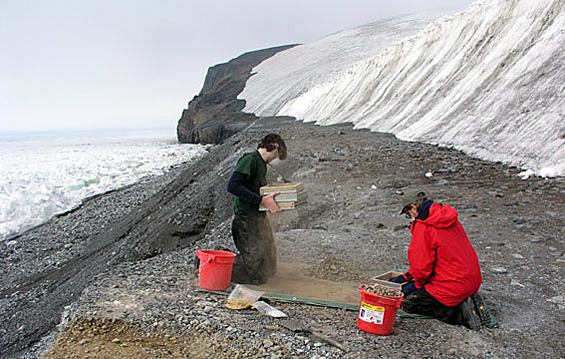Penguins on the edgeLocation of ancient colonies follow the ebb and flow of Antarctic icePosted October 30, 2009
Location, location, location. For marine ornithologist Steve Emslie “The whole pattern of the colonies coming in and out of the Ross Sea fits really nicely with the forward and backward movement of the ice sheet,” said Emslie, the principal investigator on a National Science Foundation Scientists have a pretty good idea of what the climate in Antarctica was like over the last 45 millennia thanks largely to the atmospheric record from ice cores. Less well known is the location of the ice sheet edge as the atmosphere alternately warmed and cooled. By locating and dating Adélie penguin colonies, mainly in the Ross Sea region, Emslie has been able to interpret how the ice moved. That’s because penguins re-establish their seasonal colonies in the same ice-free areas every year unless conditions force them to move. For instance, in a study published in Geology in 2007, Emslie and his colleagues, geologists Larry Coats and Kathy Licht, determined from the existence of former colonies along the Victoria Land coast that open water existed in the southern Ross Sea from about 40,000 to 27,000 years ago. Then the ice began to advance, reaching as far as Coulman Island, about 300 kilometers north of the current edge of the Ross Ice Shelf The climate pendulum began to swing the other away about 13,000 years ago with the start of the warmer Holocene. As the ice retreated back south, the penguins returned and re-colonized the coast, especially the Scott Coast in the southern Ross Sea, Emslie said. Then, about 2,000 years ago, a cold snap or perhaps the presence of too much sea ice, caused the penguins to leave their colonies for a thousand years, most apparently retreating to Cape Adare far to the north, where radiocarbon dates indicate that occupation began there at that time. “Cape Adare is now the largest Adélie penguin colony in the Antarctic, but it is definitely not the oldest,” Emslie noted. Even after ice conditions became more favorable for the Adélies to return south, they didn’t, except for some apparently intrepid birds that founded the large colonies around Ross Island today, according to Emslie. “So far, the data indicate that Adélie penguins, even though they’re super abundant on Ross Island today, that only occurred in the last 500 years,” he said. “They still have not reoccupied the Scott Coast, probably because of persistent annual sea ice that blocks access to that shoreline.” Emslie and members of his research team, including a geologist from China, will revisit previous sites at Cape Bird and Cape Crozier to collect more tissue samples such as feathers, eggshells and even mummified bodies. The scientists use the organic material for radiocarbon dating — measuring the radioactive decay of radioisotope carbon-14 — to determine the age of the remains. 
Photo Credit: Steve Emslie
A scientist examines molt layers in a glacial moraine on Beaufort Island.
The field plan also calls for searching for more remains on Beaufort Island, which hosts the oldest samples, dating back more than 40,000 years. Emslie’s group is one of very few using the historical location of animals like penguins to interpret ice conditions in the past. Another team, led by Brenda Hall Any differences? Well, it sounds like it’s much easier to locate lost penguin colonies than elephant seal colonies, where there are no definite signs to mark the remains, requiring the researchers to get down on hands and knees to search for bits of tissue from skin and hair. Not so with Adélie penguin colonies, where the birds stack pebbles into little mounds to make a nest. “Once you have an eye for what an abandoned colony looks like, they stand out pretty well. You can often see them from a distance away,” Emslie said. “I scan large areas with binoculars and tell whether or not abandoned sites are possible.” Then it’s a matter of digging into the ground in tightly controlled increments, screening for samples. “You excavate them like an archaeological site,” he explained. “There’s no other place in the world where you can have such good preservation of the same species through time that is also a good indicator of environmental change like the Adélie penguin. There’s nothing in the Arctic that we can use like that,” Emslie said. “I think it’s pretty remarkable, pretty unique to be able to do this in the Antarctic with these preserved, ancient colonies, some as old as 40,000 years looking like they were abandoned yesterday.” Back to main story: Changing diet. |



For USAP Participants |
For The Public |
For Researchers and EducatorsContact UsNational Science FoundationOffice of Polar Programs Geosciences Directorate 2415 Eisenhower Avenue, Suite W7100 Alexandria, VA 22314 Sign up for the NSF Office of Polar Programs newsletter and events. Feedback Form |


